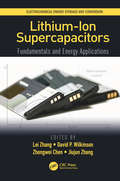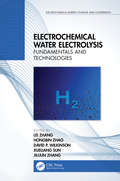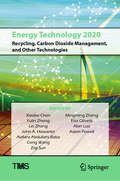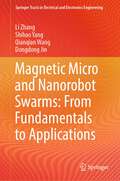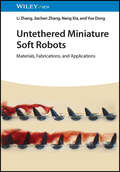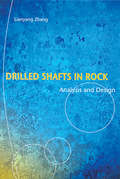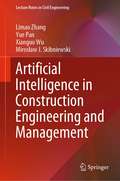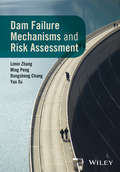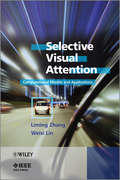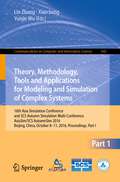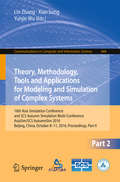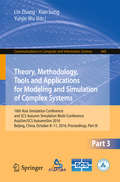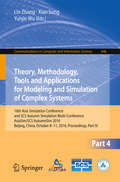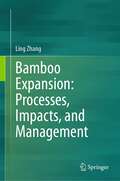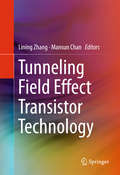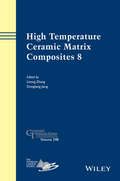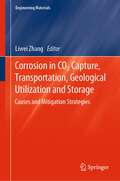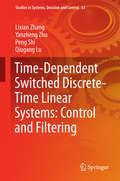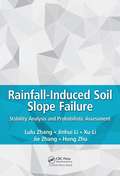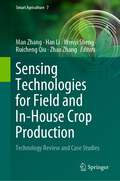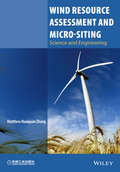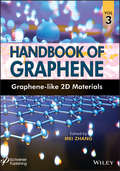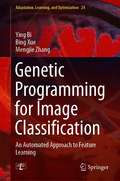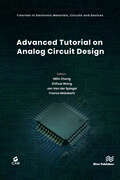- Table View
- List View
Lithium-Ion Supercapacitors: Fundamentals and Energy Applications (Electrochemical Energy Storage and Conversion)
by Lei Zhang David P. Wilkinson Zhongwei Chen Jiujun ZhangThe book provides a comprehensive understanding of the principles for operating lithium-ion supercapacitors (LISCs), their challenges, technological trends and perspectives. LISC technology has high potential to replace conventional rechargeable batteries such as lead-acid and nickel metal hydride batteries for automotive, portable electronics, and stationary applications. The book offers detailed analysis of LISCs at the material, component, and system levels to evaluate the different approaches to their integration. It also discusses economics, market, manufacture, and commercialization status of LISCs. It is an up-to-date study of an emerging field, written by experts, ideal for those in academia and industry who want a detailed explanation of the technology.
Electrochemical Water Electrolysis: Fundamentals and Technologies (Electrochemical Energy Storage and Conversion)
by Lei Zhang Jiujun Zhang Xueliang Sun David P. Wilkinson Hongbin ZhaoThis book comprehensively describes the fundamentals of electrochemical water electrolysis as well as the latest materials and technological developments. It addresses a variety of topics such as electrochemical processes, materials, components, assembly and manufacturing, and degradation mechanisms, as well as challenges and strategies. It also includes an understanding of how materials and technologies for electrochemical water electrolysis have developed in recent years, and it describes the progress in improving performance and providing benefits to energy systems and applications. Features the most recent advances in electrochemical water electrolysis to produce hydrogen Discusses cutting-edge materials and technologies for electrochemical water electrolysis Includes both experimental and theoretical approaches that can be used to guide and promote materials as well as technological development for electrochemical water electrolysis Comprises work from international leading scientists active in electrochemical energy and environmental research and development Provides invaluable information that will benefit readers from both academia and industry With contributions from researchers at the top of their fields, the book includes in-depth discussions covering the engineering of components and applied devices, making this an essential read for scientists and engineers working in the development of electrochemical energy devices and related disciplines.
Energy Technology 2020: Recycling, Carbon Dioxide Management, and Other Technologies (The Minerals, Metals & Materials Series)
by Lei Zhang Mingming Zhang Cong Wang Elsa Olivetti Ziqi Sun John A. Howarter Xiaobo Chen Alafara Abdullahi Baba Alan Luo Yulin Zhong Adam PowellThis collection addresses the pressing needs for sustainable technologies with reduced energy consumption and environmental pollutions and the development and application of alternative sustainable energy to maintain a green environment and efficient and long-lasting energy supply. Contributors represent both industry and academia and focus on new and efficient energy technologies including innovative ore beneficiation, smelting technologies, and recycling and waste heat recovery, as well as emerging novel energy solutions. The volume also covers a broad range of mature and new technological aspects of sustainable energy ecosystems, processes that improve energy efficiency, reduce thermal emissions, and reduce carbon dioxide and other greenhouse emissions. Authors also explore the valorization of materials and their embodied energy including byproducts or coproducts from ferrous and nonferrous industries, batteries, electronics, and other complex secondary materials.
Magnetic Micro and Nanorobot Swarms: From Fundamentals to Applications (Springer Tracts in Electrical and Electronics Engineering)
by Li Zhang Shihao Yang Qianqian Wang Dongdong JinThis book is focused on the attractive emerging field of micro-/nanorobot swarms (microswarms). It introduces fundamental understandings of various microswarms, including pattern generation, transformation, locomotion, and imaging. This book also demonstrates applications of micro-/nanorobot swarms in different fields, such as biomedical, environmental, and electrical applications. The detailed theoretical analysis and experimental demonstrations in this book provide readers ranging from students to researchers with a realistic picture of progress achieved in the field of micro-/nanorobot swarms.
Untethered Miniature Soft Robots: Materials, Fabrications, and Applications
by Li Zhang Jiachen Zhang Neng Xia Yue DongUntethered Miniature Soft Robots Reference on achieving contactless manipulation of soft robots, detailing high level concepts and perspectives and technical skills of soft robots Untethered Miniature Soft Robots: Materials, Fabrications, and Applications introduces the emerging field of miniature soft robots and summarizes the recent rapid development in the field to date, describing different types of functional materials to build miniature soft robots, such as silicone elastomer, carbon-based materials, hydrogels, liquid crystal polymer, flexible ferrofluid, and liquid metal, and covering the material properties, fabrication strategies, and functionalities in soft robots together with their underlying mechanisms. The book discusses magnetically, thermally, optically, and chemically actuated soft robots in depth, explores the many specific applications of miniature soft robots in biomedical, environmental, and electrical fields and summarizes the development of miniature soft robots based on soft matter, fabrication strategies, locomotion principles, sensing and actuation mechanisms. In closing, the text summarizes the opportunities and challenges faced by miniature soft robots, providing expert insight into the possible futures of this field. Written by four highly qualified academics, Untethered Miniature Soft Robots covers sample topics such as: Soft elastomer-based robots with programmable magnetization profiles and untethered soft robots based on template-aiding Working mechanisms of carbon-based materials, covering light-induced expansion and shrinkage, and humidity-induced deformation Designing microscale building blocks, modular assembly of building blocks based on Denavit-Hartenberg (DH) matrix, and inverse and forward design of modular morphing systems Material designs of magnetic liquid crystal elastomers (LCE) systems, multiple-stimuli responsiveness of magnetic LCE systems, and adaptive locomotion of magnetic LCE-based robots Controllable deformation and motion behaviors, as well as applications of ferrofluids droplet robots (FDRs), including cargo capturing, object sorting, liquid pumping/mixing, and liquid skin. Providing highly detailed and up-to-date coverage of the topic, Untethered Miniature Soft Robots serves as an invaluable and highly comprehensive reference for researchers working in this promising field across a variety of disciplines, including materials scientists, mechanical and electronics engineers, polymer chemists, and biochemists.
Drilled Shafts in Rock: Analysis and Design
by Lianyang ZhangDrilled shafts in rock are widely used as foundations of heavy structures such as highway bridges and tall buildings. Although much has been learned about the analysis and design of drilled shafts in rock, all the major findings are published in the form of reports and articles in technical journals and conference proceedings. This book i
Artificial Intelligence in Construction Engineering and Management (Lecture Notes in Civil Engineering #163)
by Limao Zhang Yue Pan Xianguo Wu Mirosław J. SkibniewskiThis book highlights the latest technologies and applications of Artificial Intelligence (AI) in the domain of construction engineering and management. The construction industry worldwide has been a late bloomer to adopting digital technology, where construction projects are predominantly managed with a heavy reliance on the knowledge and experience of construction professionals. AI works by combining large amounts of data with fast, iterative processing, and intelligent algorithms (e.g., neural networks, process mining, and deep learning), allowing the computer to learn automatically from patterns or features in the data. It provides a wide range of solutions to address many challenging construction problems, such as knowledge discovery, risk estimates, root cause analysis, damage assessment and prediction, and defect detection. A tremendous transformation has taken place in the past years with the emerging applications of AI. This enables industrial participants to operate projects more efficiently and safely, not only increasing the automation and productivity in construction but also enhancing the competitiveness globally.
Dam Failure Mechanisms and Risk Assessment
by Limin Zhang Ming Peng Dongsheng Chang Yao XuThis book integrates the physical processes of dam breaching and the mathematical aspects of risk assessment in a concise manner • The first book that introduces the causes, processes and consequences of dam failures• Integrates the physical processes of dam breaching and the mathematical aspects of risk assessment in a concise manner• Emphasizes integrating theory and practice to better demonstrate the application of risk assessment and decision methodologies to real cases• Intends to formulate dam-breaching emergency management steps in a scientific structure
Selective Visual Attention: Computational Models and Applications (Wiley - IEEE)
by Liming Zhang Weisi LinVisual attention is a relatively new area of study combining a number of disciplines: artificial neural networks, artificial intelligence, vision science and psychology. The aim is to build computational models similar to human vision in order to solve tough problems for many potential applications including object recognition, unmanned vehicle navigation, and image and video coding and processing. In this book, the authors provide an up to date and highly applied introduction to the topic of visual attention, aiding researchers in creating powerful computer vision systems. Areas covered include the significance of vision research, psychology and computer vision, existing computational visual attention models, and the authors' contributions on visual attention models, and applications in various image and video processing tasks. This book is geared for graduates students and researchers in neural networks, image processing, machine learning, computer vision, and other areas of biologically inspired model building and applications. The book can also be used by practicing engineers looking for techniques involving the application of image coding, video processing, machine vision and brain-like robots to real-world systems. Other students and researchers with interdisciplinary interests will also find this book appealing. Provides a key knowledge boost to developers of image processing applications Is unique in emphasizing the practical utility of attention mechanisms Includes a number of real-world examples that readers can implement in their own work: robot navigation and object selection image and video quality assessment image and video coding Provides codes for users to apply in practical attentional models and mechanisms
Theory, Methodology, Tools and Applications for Modeling and Simulation of Complex Systems
by Lin Zhang Xiao Song Yunjie WuThis four-volume set (CCIS 643, 644, 645, 646) constitutes the refereed proceedings of the 16th Asia Simulation Conference and the First Autumn Simulation Multi-Conference, AsiaSim / SCS AutumnSim 2016, held in Beijing, China, in October 2016. The 265 revised full papers presented were carefully reviewed and selected from 651 submissions. The papers in this first volume of the set are organized in topical sections on modeling and simulation theory and methodology; model engineering for system of systems; high performance computing and simulation; modeling and simulation for smart city.
Theory, Methodology, Tools and Applications for Modeling and Simulation of Complex Systems
by Lin Zhang Xiao Song Yunjie WuThis four-volume set (CCIS 643, 644, 645, 646) constitutes the refereed proceedings of the 16th Asia Simulation Conference and the First Autumn Simulation Multi-Conference, AsiaSim / SCS AutumnSim 2016, held in Beijing, China, in October 2016. The 265 revised full papers presented were carefully reviewed and selected from 651 submissions. The papers in this first volume of the set are organized in topical sections on modeling and simulation theory and methodology; model engineering for system of systems; high performance computing and simulation; modeling and simulation for smart city.
Theory, Methodology, Tools and Applications for Modeling and Simulation of Complex Systems
by Lin Zhang Xiao Song Yunjie WuThis four-volume set (CCIS 643, 644, 645, 646) constitutes the refereed proceedings of the 16th Asia Simulation Conference and the First Autumn Simulation Multi-Conference, AsiaSim / SCS AutumnSim 2016, held in Beijing, China, in October 2016. The 265 revised full papers presented were carefully reviewed and selected from 651 submissions. The papers in this first volume of the set are organized in topical sections on modeling and simulation theory and methodology; model engineering for system of systems; high performance computing and simulation; modeling and simulation for smart city.
Theory, Methodology, Tools and Applications for Modeling and Simulation of Complex Systems
by Lin Zhang Xiao Song Yunjie WuThis four-volume set (CCIS 643, 644, 645, 646) constitutes the refereed proceedings of the 16th Asia Simulation Conference and the First Autumn Simulation Multi-Conference, AsiaSim / SCS AutumnSim 2016, held in Beijing, China, in October 2016. The 265 revised full papers presented were carefully reviewed and selected from 651 submissions. The papers in this first volume of the set are organized in topical sections on modeling and simulation theory and methodology; model engineering for system of systems; high performance computing and simulation; modeling and simulation for smart city.
Bamboo Expansion: Processes, Impacts, and Management
by Ling ZhangThis book highlights processes, impacts and management practices of bamboo expansion occurring in areas where it is distributed around the world. Although not conceptually plant invasions, bamboo expansion has been considered an “invasion” based on its characteristics and the impacts it caused on adjacent ecosystems it expanded into, including altered element cycling, transformed soil microbial community compositions, decreased biodiversity, fluctuated primary productions, etc. However, the processes and impacts during or after complete expansion and the underlying mechanisms of successful expansion, are still unclear. The ecological effects of bamboo expansion are not given full consideration and are not thoroughly understood. Based on the latest studies, this book synthesizes research progress of bamboo expansion effects on the soil abiotic environment, soil microbial community compositions, plant characteristics, ecosystem biodiversity, element cycling process, and ecological effects of primary management practice, etc. This book will provide a thorough understanding of ecological changes following bamboo expansions, benefit the effective control of expanding bamboo with respect to decreased biodiversity and mitigation of global change, and accurate prediction and evaluation of bamboo expansion impacts currently and in the future occur around the world. This book presents critical points that need further investigation based on the latest findings, which will be helpful for ecological researchers, policymakers, forestry workers, or graduate and PhD students.
Tunneling Field Effect Transistor Technology
by Lining Zhang Mansun ChanThis book provides a single-source reference to the state-of-the art intunneling field effect transistors (TFETs). Readers will learn the TFETsphysics from advanced atomistic simulations, the TFETs fabrication process andthe important roles that TFETs will play in enabling integrated circuit designsfor power efficiency.
Nutritional Toxicology
by Lishi ZhangThis book provides a broad overview of the chemicals in food that have the potential to induce adverse health effects. Nutritional Toxicology is an interaction of nutrition, toxicology, biochemistry and food science, etc. Its main research scope involves the effects of nutrients on metabolisms of toxicants and their mechanisms, the interaction of the toxicants and contaminants originated from diet with nutrients and nutrition process, the adverse health outcome of nutrients excess, as well as methodology of research and related food and nutrition regulation process. Also the risk assessment of toxicants and contaminants in foods, and risk benefit assessment of nutrients (dietary supplementation) has become an emerging topic. This book provides novel and provocative insights into the fields of nutrition, food science and toxicology. It also offers a state-of-the-art report on recent discoveries concerning nutritional toxicology and where the field is going. It mainly focuses on advances made over the past 20 years. It will benefit graduate students, researchers and food and nutrition related regulation parties.
High Temperature Ceramic Matrix Composites 8
by Litong Zhang Dongliang JiangThis proceedings contains 78 papers from the 8th International Conference on High Temperature Ceramic Matrix Composites, held September 22-26, 2013 in Xi'an, Shaanxi, China. Chapters include: Ceramic Genome, Computational Modeling, and Design Advanced Ceramic Fibers, Interfaces, and Interphases Nanocomposite Materials and Systems Polymer Derived Ceramics and Composites Fiber Reinforced Ceramic MatrixComposites Carbon-Carbon Composites: Materials, Systems, and Applications Ultra High Temperature Ceramics and MAX Phase Materials Thermal and Environmental Barrier Coatings
Corrosion in CO2 Capture, Transportation, Geological Utilization and Storage: Causes and Mitigation Strategies (Engineering Materials)
by Liwei ZhangThis book systematically discusses the operational stages with high risk of CO2-induced corrosion in CCUS projects, and related measures for corrosion control. CO2 capture, utilization, and storage (CCUS) is a key technology to mitigate climate change and substantially reduce greenhouse gas emissions from fossil fuels. CCUS deals with high concentration CO2, which is very corrosive in a humid environment. Therefore, it is very important to characterize, monitor, and mitigate CO2-induced corrosion in all processes of the CCUS operation chain. Some corrosion control techniques included in this book (e.g., CO2-resisting wellbore cement additives) are beneficial for corrosion control research and engineering practices. This book belongs to the field of corrosion science and engineering, and the expected readership is researchers and engineers working on CCUS.
Time-Dependent Switched Discrete-Time Linear Systems: Control and Filtering
by Lixian Zhang Yanzheng Zhu Peng Shi Qiugang LuThisbook focuses on the basic control and filtering synthesis problems fordiscrete-time switched linear systems under time-dependent switching signals. Chapter 1, as an introduction of the book, gives the backgrounds andmotivations of switched systems, the definitions of the typical time-dependentswitching signals, the differences and links to other types of systems withhybrid characteristics and a literature review mainly on the control andfiltering for the underlying systems. By summarizing the multiple Lyapunov-likefunctions (MLFs) approach in which different requirements on comparisons ofLyapunov function values at switching instants, a series of methodologies are developed for the issues onstability and stabilization, and l2-gainperformance or tube-based robustness for l∞disturbance, respectively, in Chapters 2 and 3. Chapters 4 and 5 are devoted tothe control and filtering problems for the time-dependent switched linearsystems with either polytopic uncertainties or measurable time-varyingparameters in different sense of disturbances. The asynchronous switchingproblem, where there is time lag between the switching of the currentlyactivated system mode and the controller/filter to be designed, is investigatedin Chapter 6. The systems with various time delays under typical time-dependentswitching signals are addressed in Chapter 7.
Rainfall-Induced Soil Slope Failure: Stability Analysis and Probabilistic Assessment
by Lulu Zhang Jinhui Li Xu Li Jie Zhang Hong ZhuRainfall-induced landslides are common around the world. With global climate change, their frequency is increasing and the consequences are becoming greater. Previous studies assess them mostly from the perspective of a single discipline—correlating landslides with rainstorms, geomorphology and hydrology in order to establish a threshold prediction value for rainfall-induced landslides; analyzing the slope’s stability using a geomechanical approach; or assessing the risk from field records. Rainfall Induced Soil Slope Failure: Stability Analysis and Probabilistic Assessment integrates probabilistic approaches with the geotechnical modeling of slope failures under rainfall conditions with unsaturated soil. It covers theoretical models of rainfall infiltration and stability analysis, reliability analysis based on coupled hydro-mechanical modelling, stability of slopes with cracks, gravels and spatial heterogenous soils, and probabilistic model calibration based on measurement. It focuses on the uncertainties involved with rainfall-induced landslides and presents state-of-the art techniques and methods which characterize the uncertainties and quantify the probabilities and risk of rainfall-induced landslide hazards. Additionally, the authors cover: The failure mechanisms of rainfall-induced slope failure Commonly used infiltration and stability methods The infiltration and stability of natural soil slopes with cracks and colluvium materials Stability evaluation methods based on probabilistic approaches The effect of spatial variability on unsaturated soil slopes and more
Sensing Technologies for Field and In-House Crop Production: Technology Review and Case Studies (Smart Agriculture #7)
by Man Zhang Han Li Wenyi Sheng Ruicheng Qiu Zhao ZhangThis book focuses on state-of-the-art sensing and automation technologies for field crops and in-house product production and provides a lot of innovative knowledge on image processing, AI algorithms and applications in agriculture, and robotics. This book provides undergraduate or graduate students with take-away knowledge for unmanned agricultural production, including but not limited to corn disease detection, wheat head detection and counting, and soil nutrient condition monitoring. The first three chapters focus on reviewing plant phenotyping sensing technology and robotics and soil nutrient monitoring, followed by in-house crop sensing robotics. Then two case studies on corn and the other two case studies on wheat are presented.
Wind Resource Assessment and Micro-siting: Science and Engineering
by Matthew Huaiquan ZhangCovers all the key areas of wind resource assessment technologies from an engineer’s perspective Focuses on wind analysis for wind plant siting, design and analysis Addresses all aspects from atmospheric boundary layer characteristics, to wind resource measurement systems, uncertainties in measurements, computations and analyses, to plant performance Covers the basics of atmospheric science through to turbine siting, turbine responses, and to environmental impacts Contents can be used for research purposes as well as a go-to reference guide, written from the perspective of a hands-on engineer Topic is of ongoing major international interest for its economic and environmental benefits
Handbook of Graphene: Graphene-like 2D Materials
by Mei ZhangThe third volume in a series of handbooks on graphene research and applicationsGraphene is a valuable nanomaterial used in technology. This handbook is focused on Graphene-Like 2D Materials. The Handbook of Graphene, Volume 3 covers topics that include planar graphene superlattices; magnetic and optical properties of graphene materials with porous defects; and nanoelectronic application of graphyne and its structural derivatives.
Genetic Programming for Image Classification: An Automated Approach to Feature Learning (Adaptation, Learning, and Optimization #24)
by Mengjie Zhang Ying Bi Bing XueThis book offers several new GP approaches to feature learning for image classification. Image classification is an important task in computer vision and machine learning with a wide range of applications. Feature learning is a fundamental step in image classification, but it is difficult due to the high variations of images. Genetic Programming (GP) is an evolutionary computation technique that can automatically evolve computer programs to solve any given problem. This is an important research field of GP and image classification. No book has been published in this field. This book shows how different techniques, e.g., image operators, ensembles, and surrogate, are proposed and employed to improve the accuracy and/or computational efficiency of GP for image classification. The proposed methods are applied to many different image classification tasks, and the effectiveness and interpretability of the learned models will be demonstrated. This book is suitable as a graduate and postgraduate level textbook in artificial intelligence, machine learning, computer vision, and evolutionary computation.
Advanced Tutorial on Analog Circuit Design
by Milin Zhang Zhihua Wang Jan Van der Spiegel Franco MalobertiThis book is a summary of analog circuit design related lectures from IEEE Advanced CMOS Technology School (ACTS) 2019. The topics cover continuous-time delta-sigma data converter, switched-capacitor power converter, ADC and power management IC. The slides are selected from the handouts, while the text was edited according to the lecturers talk. ACTS is a joint activity supported by the IEEE Circuit and System Society (CASS) and the IEEE Solid-State Circuits Society (SSCS). The goal of the school is to provide society members as well researchers and engineers from industry the opportunity to learn about new emerging areas from leading experts in the field. ACTS is an example of high-level continuous education for junior engineers, teachers in academe, and students. ACTS was the results of a successful collaboration between societies, the local chapter leaders, and industry leaders.
